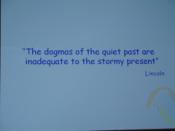I this paper we are going to talk about how business and people in conditions of comprehension. We are going to cover how social networking affects the progress of an association and possibly augment it employee's comprehension.
The learning organization, three definitions of a learning organization;1)Learning organizations [are] organizations where people constantly enlarge their competence to generate the outcome they truthfully need, where new and expansive patterns of idea are nurtured, where combined ambition is set liberated, and where populace are constantly learning to observe the whole jointly. (Senge 1990)2)The Learning Company is a vision of what may be probable. It is not brought about plainly by teaching persons; it can only occur as a consequence of learning at the entire organization level. Learning Company is an association that facilitates the learning of all its members and incessantly transforms itself. (Pedler et. al. 1991: 1)3) Learning organizations are distinguished by total employee participation in a procedure of collaboratively conducted, jointly held responsible alteration directed towards shared values or principles.
(Watkins and Marsick 1992: 118)Learning organizations offer unremitting educational prospect, use learning to get in touch with their goals, connect individual performance with directorial performance, encourage query and conversation, creating it secure for citizens to share openly and take risks, clinch ingenious anxiety as a basis of force and revitalization and are incessantly alert of and intermingle with their surroundings. (Kerka 1995)As Kerka (1995) goes onto mention, the five disciplines that Peter Senge goes on to recognize (personal mastery, mental models, shared vision, team learning and systems thinking) are the keys to attain this kind of organization. Here, rather than focus too powerfully on the five disciplines (these can be followed up in our review of Senge and the learning organization) we want to remark momentarily on his use...


